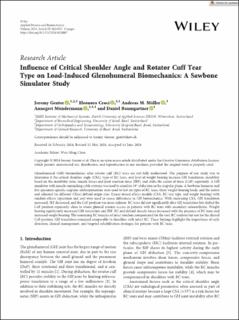Bitte benutzen Sie diese Kennung, um auf die Ressource zu verweisen:
https://doi.org/10.21256/zhaw-31215| Publikationstyp: | Beitrag in wissenschaftlicher Zeitschrift |
| Art der Begutachtung: | Peer review (Publikation) |
| Titel: | Influence of critical shoulder angle and rotator cuff tear type on load-induced glenohumeral biomechanics : a Sawbone simulator study |
| Autor/-in: | Genter, Jeremy Croci, Eleonora Müller, Andreas M. Mündermann, Annegret Baumgartner, Daniel |
| et. al: | No |
| DOI: | 10.1155/2024/4624007 10.21256/zhaw-31215 |
| Erschienen in: | Applied Bionics and Biomechanics |
| Band(Heft): | 2024 |
| Heft: | 4624007 |
| Erscheinungsdatum: | 2-Jul-2024 |
| Verlag / Hrsg. Institution: | Wiley |
| ISSN: | 1176-2322 1754-2103 |
| Sprache: | Englisch |
| Fachgebiet (DDC): | 617.5: Orthopädische Chirurgie |
| Zusammenfassung: | Glenohumeral (GH) biomechanics after rotator cuff (RC) tears are not fully understood. The purpose of our study was to determine if the critical shoulder angle (CSA), type of RC tears, and level of weight bearing increase GH translation, instability based on the instability ratio, muscle forces and joint reaction force (JRF), and shifts the center of force (CoF) superiorly. A GH simulator with muscle-mimicking cable systems was used to simulate 30° abduction in the scapular plane. A Sawbone humerus and five specimen-specific scapular anthropometries were used to test six types of RC tears, three weight-bearing loads, and the native and adjusted (to different CSAs) deltoid origin sites. Linear mixed effects models (CSA, RC tear type, and weight bearing) with random effects (specimen and sex) were used to assess differences in GH biomechanics. With increasing CSA, GH translation increased, JRF decreased, and the CoF position was more inferior. RC tears did not significantly alter GH translation but shifted the CoF position superiorly, close to where glenoid erosion occurs in patients with RC tears with secondary osteoarthritis. Weight bearing significantly increased GH translation and JRF. RC and deltoid muscle forces increased with the presence of RC tears and increased weight bearing. The remaining RC muscles of intact tendons compensated for the torn RC tendons but not for the altered CoF position. GH translation remained comparable to shoulders with intact RC. These findings highlight the importance of early detection, clinical management, and targeted rehabilitation strategies for patients with RC tears. |
| URI: | https://digitalcollection.zhaw.ch/handle/11475/31215 |
| Zugehörige Forschungsdaten: | https://doi.org/10.5281/zenodo.10663334 |
| Volltext Version: | Publizierte Version |
| Lizenz (gemäss Verlagsvertrag): | CC BY 4.0: Namensnennung 4.0 International |
| Departement: | School of Engineering |
| Organisationseinheit: | Institut für Mechanische Systeme (IMES) |
| Publiziert im Rahmen des ZHAW-Projekts: | Einfluss der zusätzlichen Gewichtsbelastung auf die belastungsinduzierten Veränderungen der glenohumeralen Translation bei Patienten mit Rotatorenmanschettenriss - ein translatorischer Ansatz |
| Enthalten in den Sammlungen: | Publikationen School of Engineering |
Dateien zu dieser Ressource:
| Datei | Beschreibung | Größe | Format | |
|---|---|---|---|---|
| 2024_Genter-etal_Influence-of-critical-shoulder-angle-and-rotator-cuff-tear.pdf | 853.25 kB | Adobe PDF |  Öffnen/Anzeigen |
Zur Langanzeige
Genter, J., Croci, E., Müller, A. M., Mündermann, A., & Baumgartner, D. (2024). Influence of critical shoulder angle and rotator cuff tear type on load-induced glenohumeral biomechanics : a Sawbone simulator study. Applied Bionics and Biomechanics, 2024(4624007). https://doi.org/10.1155/2024/4624007
Genter, J. et al. (2024) ‘Influence of critical shoulder angle and rotator cuff tear type on load-induced glenohumeral biomechanics : a Sawbone simulator study’, Applied Bionics and Biomechanics, 2024(4624007). Available at: https://doi.org/10.1155/2024/4624007.
J. Genter, E. Croci, A. M. Müller, A. Mündermann, and D. Baumgartner, “Influence of critical shoulder angle and rotator cuff tear type on load-induced glenohumeral biomechanics : a Sawbone simulator study,” Applied Bionics and Biomechanics, vol. 2024, no. 4624007, Jul. 2024, doi: 10.1155/2024/4624007.
GENTER, Jeremy, Eleonora CROCI, Andreas M. MÜLLER, Annegret MÜNDERMANN und Daniel BAUMGARTNER, 2024. Influence of critical shoulder angle and rotator cuff tear type on load-induced glenohumeral biomechanics : a Sawbone simulator study. Applied Bionics and Biomechanics. 2 Juli 2024. Bd. 2024, Nr. 4624007. DOI 10.1155/2024/4624007
Genter, Jeremy, Eleonora Croci, Andreas M. Müller, Annegret Mündermann, and Daniel Baumgartner. 2024. “Influence of Critical Shoulder Angle and Rotator Cuff Tear Type on Load-Induced Glenohumeral Biomechanics : A Sawbone Simulator Study.” Applied Bionics and Biomechanics 2024 (4624007). https://doi.org/10.1155/2024/4624007.
Genter, Jeremy, et al. “Influence of Critical Shoulder Angle and Rotator Cuff Tear Type on Load-Induced Glenohumeral Biomechanics : A Sawbone Simulator Study.” Applied Bionics and Biomechanics, vol. 2024, no. 4624007, July 2024, https://doi.org/10.1155/2024/4624007.
Alle Ressourcen in diesem Repository sind urheberrechtlich geschützt, soweit nicht anderweitig angezeigt.